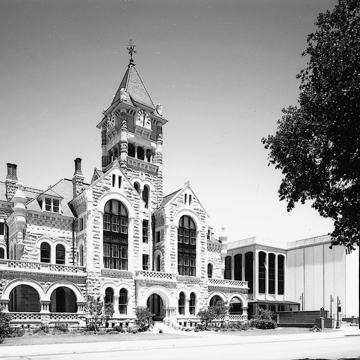The Victoria County Courthouse is the only surviving courthouse along the Gulf Coast designed by J. Riely Gordon of San Antonio, the dean of nineteenth-century Texas county courthouse architects. As architectural historian Jay C. Henry deduced, the Victoria courthouse derives from the design of one of the most admired American public buildings of the period, the Allegheny County Courthouse in Pittsburgh by H. H. Richardson of 1888. Gordon's tall centered tower, facing De León Plaza, disguises the fact that the courthouse is almost square in plan, with offices and a district courtroom on the second floor organized around a square interior patio. Cleaning the courthouse's Texas limestone exterior as part of a rehabilitation by Austin architect David Hoffman in 1998 restored the vibrant contrast between the rusticated finish of the slightly grayish stone walls and the smooth bands of lighter stone that frame openings and compose such decorative features as the bartizan towers projecting from the building's corners. Columns and steps of pink granite and tile paving in the loggias enhance the courthouse's sense of materiality and texture.
The courthouse is somewhat squeezed by the three-story county administration building next door by Christopher Di Stefano and Associates of 1967. More considerate are the one-story Victoria County Courthouse Annex (now the Tax Assessor and Collector's office, 1953) by Robert M. Stein at 206 W. Constitution Avenue, behind the courthouse, and the three-story Victoria County Jail (1940) by Atlee B. and Robert M. Ayres of San Antonio and Kai J. Leffland of Victoria at 210 W. Constitution, which complement Gordon's courthouse with their characteristic 1940s combination of cream limestone and buff brick.
De León Plaza features radiating concrete sidewalks that emanate from a bandstand constructed in 1885, although it is not original to the square. Mature live oak and pecan trees endow the plaza with its parklike character. Located in the plaza is The Last Stand (1912) by San Antonio sculptor Pompeo Coppini.
Framing De León Plaza are the headquarters of Victoria's two oldest financial institutions, identified with the two ranching dynasties commemorated in the original names of their buildings, O'Connor and Welder. On the plaza's north side at 101 W. Goodwin Avenue is Victoria Bank and Trust's (now Wells Fargo) twelve-story One O'Connor Plaza (1984) by Morris Aubry Architects of Houston, and on the south side at 101 S. Main Street is Victoria National's (now First Victoria National Bank) five-story John J. Welder Building (1913; 1959, 1980 refaced and expanded) by Charles H. Page and Brother. Thomas O'Connor and John J. Welder shared common great-great-grandparents; a son of these great-great-grandparents was Irish empresario James Power, cofounder of the Power and Hewetson colony and responsible for bringing family members from Ireland to Mexican Texas in the 1830s. Both branches lived in Refugio County, where their ranches were headquartered, until Victoria's rise to regional prominence led them and other Coastal Bend cattle kings to relocate here in the 1870s and 1880s.


